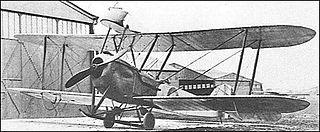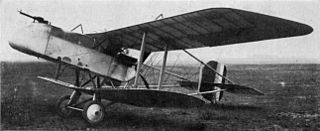Related Research Articles

Between 1911 and 1914, the Royal Aircraft Factory used the F.E.2 designation for three quite different aircraft that shared only a common "Farman" pusher biplane layout.

The Vickers F.B.5 was a British two-seat pusher military biplane of the First World War. Armed with a single .303 in (7.7 mm) Lewis gun operated by the observer in the front of the nacelle, it was the first aircraft purpose-built for air-to-air combat to see service, making it the world's first operational fighter aircraft.

The Short Springbok was a two-seat, all-metal reconnaissance biplane produced for the British Air Ministry in the 1920s. All together six aircraft of the Springbok design were built but none entered service with the armed forces.

The Vickers F.B.26 Vampire was a British single-seat pusher biplane fighter built by Vickers during the First World War.

The Vickers F.B.12 was a biplane pusher fighter aircraft developed during World War I by Vickers Limited. The failure of the engine for which it was designed, and the obsolescence of the pusher configuration, resulted in its remaining an experimental type only.
The Grahame-White Ganymede was a prototype British heavy night bomber intended to serve with the Royal Air Force in the First World War. A large, three-engined, twin-boom biplane, the sole prototype Ganymede did not fly until after the war had ended, and although an attempt was made to convert the aircraft to an airliner, it was unsuccessful.

The Gloster TC.33 was a large four-engined biplane designed for troop carrying and medical evacuation in the early 1930s. Only one was built.

The Vickers Type 161 was an unusual 1930s pusher biplane interceptor, designed to attack aircraft from below with a single upward-angle large calibre gun. The aircraft flew well but the concept was abandoned and only one was built.

The Vickers Type 253 was a single-engined two-seat biplane general-purpose military machine built to a 1930 government specification. It won a production contract, but this was transferred to the same company's monoplane equivalent, the Wellesley. Only one Type 253 was built.

The Vickers F.B.11 was a prototype British three-seat escort fighter of the First World War. A large single-engined biplane, it carried one gunner in a nacelle mounted on the upper wing to give an allround field of fire. Only a single example was completed.
The Vickers E.F.B.8 was a prototype British twin-engined fighter of the First World War. It was abandoned after only one aircraft was built, single-engined fighters being considered to have superior manoeuvrability.
The Sopwith Gunbus was a British fighter aircraft of the First World War. It was a single-engined pusher biplane based on a floatplane built by Sopwith before the war for Greece. Small numbers were built and used by the British Royal Naval Air Service, mainly as a trainer.

The Royal Aircraft Factory F.E.9 was a prototype British two-seat fighter-reconnaissance aircraft of the First World War. A single-engined pusher biplane of 1917, the F.E.9 had poor performance and handling, and only three were built.

The Royal Aircraft Factory N.E.1 was a prototype British Night fighter of the First World War. A single-engined pusher biplane, it was a development of the Royal Aircraft Factory's earlier F.E.9 fighter, but was not successful, only six being built.
The Royal Aircraft Factory A.E.3, also known as the Farnborough Ram, was a prototype British armoured ground attack aircraft of the First World War. The A.E.3, which was a development of the Royal Aircraft Factory's N.E.1 night fighter, was a two-seat single-engined pusher biplane. Three were built in 1918, but the type was unsuccessful, with no further production ensuing.
The Sopwith 3F.2 Hippo was a prototype British two-seat fighter aircraft of the First World War. It was a single-engined biplane with considerable negative stagger. It was not successful, the Bristol F.2 Fighter being preferred by the Royal Flying Corps.
The Vickers F.B.24 was a British two-seat fighter aircraft of the First World War. Only a few prototypes were built, as, although it had good performance, the Bristol F.2 Fighter was preferred.

The Vickers F.B.25 was a British two-seat night fighter prototype of World War I designed to attack enemy airships. Completed in 1917, it failed in its official flight tests that year and no order for production resulted.
The Grahame-White Type VI was an early British military aircraft manufactured by the Grahame-White Aviation Company. Only one was built but after an abortive flight development was abandoned.

The Siemens-Schuckert L.I was a large, three-engined biplane bomber aircraft, built in Germany towards the end of World War I. It was a twin boom design, strongly influenced by the successful Caproni Ca.3. Three were built but not used operationally.
References
- Bruce, J. M. (April–July 1980). "Vickers' First Fighters". Air Enthusiast . No. 12. pp. 54–70. ISSN 0143-5450.
- Mason F.K. The British Fighter Since 1912 London: Putnam, 1992. ISBN 0-85177-852-6